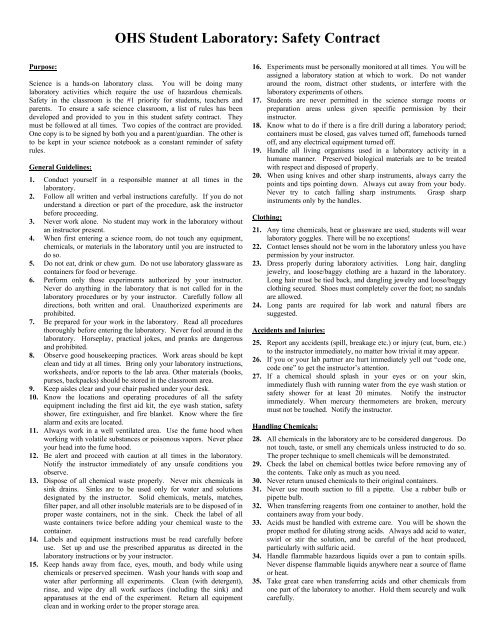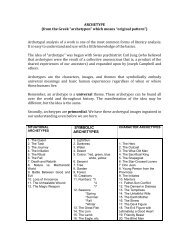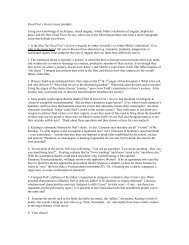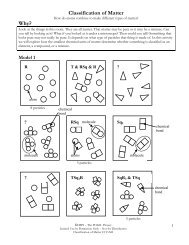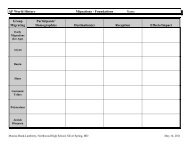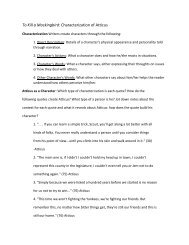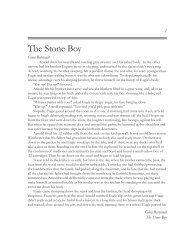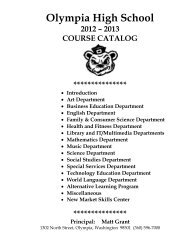OHS Student Laboratory: Safety Contract
OHS Student Laboratory: Safety Contract
OHS Student Laboratory: Safety Contract
Create successful ePaper yourself
Turn your PDF publications into a flip-book with our unique Google optimized e-Paper software.
Purpose:<br />
<strong>OHS</strong> <strong>Student</strong> <strong>Laboratory</strong>: <strong>Safety</strong> <strong>Contract</strong><br />
Science is a hands-on laboratory class. You will be doing many<br />
laboratory activities which require the use of hazardous chemicals.<br />
<strong>Safety</strong> in the classroom is the #1 priority for students, teachers and<br />
parents. To ensure a safe science classroom, a list of rules has been<br />
developed and provided to you in this student safety contract. They<br />
must be followed at all times. Two copies of the contract are provided.<br />
One copy is to be signed by both you and a parent/guardian. The other is<br />
to be kept in your science notebook as a constant reminder of safety<br />
rules.<br />
General Guidelines:<br />
1. Conduct yourself in a responsible manner at all times in the<br />
laboratory.<br />
2. Follow all written and verbal instructions carefully. If you do not<br />
understand a direction or part of the procedure, ask the instructor<br />
before proceeding.<br />
3. Never work alone. No student may work in the laboratory without<br />
an instructor present.<br />
4. When first entering a science room, do not touch any equipment,<br />
chemicals, or materials in the laboratory until you are instructed to<br />
do so.<br />
5. Do not eat, drink or chew gum. Do not use laboratory glassware as<br />
containers for food or beverage.<br />
6. Perform only those experiments authorized by your instructor.<br />
Never do anything in the laboratory that is not called for in the<br />
laboratory procedures or by your instructor. Carefully follow all<br />
directions, both written and oral. Unauthorized experiments are<br />
prohibited.<br />
7. Be prepared for your work in the laboratory. Read all procedures<br />
thoroughly before entering the laboratory. Never fool around in the<br />
laboratory. Horseplay, practical jokes, and pranks are dangerous<br />
and prohibited.<br />
8. Observe good housekeeping practices. Work areas should be kept<br />
clean and tidy at all times. Bring only your laboratory instructions,<br />
worksheets, and/or reports to the lab area. Other materials (books,<br />
purses, backpacks) should be stored in the classroom area.<br />
9. Keep aisles clear and your chair pushed under your desk.<br />
10. Know the locations and operating procedures of all the safety<br />
equipment including the first aid kit, the eye wash station, safety<br />
shower, fire extinguisher, and fire blanket. Know where the fire<br />
alarm and exits are located.<br />
11. Always work in a well ventilated area. Use the fume hood when<br />
working with volatile substances or poisonous vapors. Never place<br />
your head into the fume hood.<br />
12. Be alert and proceed with caution at all times in the laboratory.<br />
Notify the instructor immediately of any unsafe conditions you<br />
observe.<br />
13. Dispose of all chemical waste properly. Never mix chemicals in<br />
sink drains. Sinks are to be used only for water and solutions<br />
designated by the instructor. Solid chemicals, metals, matches,<br />
filter paper, and all other insoluble materials are to be disposed of in<br />
proper waste containers, not in the sink. Check the label of all<br />
waste containers twice before adding your chemical waste to the<br />
container.<br />
14. Labels and equipment instructions must be read carefully before<br />
use. Set up and use the prescribed apparatus as directed in the<br />
laboratory instructions or by your instructor.<br />
15. Keep hands away from face, eyes, mouth, and body while using<br />
chemicals or preserved specimen. Wash your hands with soap and<br />
water after performing all experiments. Clean (with detergent),<br />
rinse, and wipe dry all work surfaces (including the sink) and<br />
apparatuses at the end of the experiment. Return all equipment<br />
clean and in working order to the proper storage area.<br />
16. Experiments must be personally monitored at all times. You will be<br />
assigned a laboratory station at which to work. Do not wander<br />
around the room, distract other students, or interfere with the<br />
laboratory experiments of others.<br />
17. <strong>Student</strong>s are never permitted in the science storage rooms or<br />
preparation areas unless given specific permission by their<br />
instructor.<br />
18. Know what to do if there is a fire drill during a laboratory period;<br />
containers must be closed, gas valves turned off, fumehoods turned<br />
off, and any electrical equipment turned off.<br />
19. Handle all living organisms used in a laboratory activity in a<br />
humane manner. Preserved biological materials are to be treated<br />
with respect and disposed of properly.<br />
20. When using knives and other sharp instruments, always carry the<br />
points and tips pointing down. Always cut away from your body.<br />
Never try to catch falling sharp instruments. Grasp sharp<br />
instruments only by the handles.<br />
Clothing:<br />
21. Any time chemicals, heat or glassware are used, students will wear<br />
laboratory goggles. There will be no exceptions!<br />
22. Contact lenses should not be worn in the laboratory unless you have<br />
permission by your instructor.<br />
23. Dress properly during laboratory activities. Long hair, dangling<br />
jewelry, and loose/baggy clothing are a hazard in the laboratory.<br />
Long hair must be tied back, and dangling jewelry and loose/baggy<br />
clothing secured. Shoes must completely cover the foot; no sandals<br />
are allowed.<br />
24. Long pants are required for lab work and natural fibers are<br />
suggested.<br />
Accidents and Injuries:<br />
25. Report any accidents (spill, breakage etc.) or injury (cut, burn, etc.)<br />
to the instructor immediately, no matter how trivial it may appear.<br />
26. If you or your lab partner are hurt immediately yell out “code one,<br />
code one” to get the instructor’s attention.<br />
27. If a chemical should splash in your eyes or on your skin,<br />
immediately flush with running water from the eye wash station or<br />
safety shower for at least 20 minutes. Notify the instructor<br />
immediately. When mercury thermometers are broken, mercury<br />
must not be touched. Notify the instructor.<br />
Handling Chemicals:<br />
28. All chemicals in the laboratory are to be considered dangerous. Do<br />
not touch, taste, or smell any chemicals unless instructed to do so.<br />
The proper technique to smell chemicals will be demonstrated.<br />
29. Check the label on chemical bottles twice before removing any of<br />
the contents. Take only as much as you need.<br />
30. Never return unused chemicals to their original containers.<br />
31. Never use mouth suction to fill a pipette. Use a rubber bulb or<br />
pipette bulb.<br />
32. When transferring reagents from one container to another, hold the<br />
containers away from your body.<br />
33. Acids must be handled with extreme care. You will be shown the<br />
proper method for diluting strong acids. Always add acid to water,<br />
swirl or stir the solution, and be careful of the heat produced,<br />
particularly with sulfuric acid.<br />
34. Handle flammable hazardous liquids over a pan to contain spills.<br />
Never dispense flammable liquids anywhere near a source of flame<br />
or heat.<br />
35. Take great care when transferring acids and other chemicals from<br />
one part of the laboratory to another. Hold them securely and walk<br />
carefully.
Handling Glassware and Equipment:<br />
36. Carry glass tubing, especially long pieces, in a vertical position to<br />
minimize the likelihood of breakage or injury.<br />
37. Never handle broken glass with your bare hands. Use a brush and a<br />
dustpan to clean up broken glass. Place broken or waste glass in the<br />
designated broken glass container.<br />
38. Inserting and removing glass tubing from rubber stoppers can be<br />
dangerous. Always lubricate glassware (tubing, thistle tubes,<br />
thermometers, etc.) before attempting to insert it into a stopper.<br />
Always protect your hands with towels or cotton gloves when<br />
inserting glass tubing, or removing it from, a rubber stopper. If a<br />
piece of glassware becomes “frozen” in a stopper, take it to your<br />
instructor for removal.<br />
39. Fill the wash bottles only with distilled water and use only as<br />
intended, ex. rinsing glassware, or adding water to a container.<br />
40. When removing an electrical plug from its socket, grip the plug, not<br />
the electrical cord. Hands must be completely dry before touching<br />
an electrical switch, plug, or outlet.<br />
41. Examine the glassware before each use. Never use chipped or<br />
cracked glassware. Never use dirty glassware.<br />
42. Report damaged electrical equipment immediately. Look for things<br />
such as frayed cords, exposed wires, and loose connections. Do not<br />
use damaged electrical equipment.<br />
43. If you do not understand how to use a piece of equipment, ask the<br />
instructor for help.<br />
44. Do not immerse hot glassware in cold water, it may shatter.<br />
Heating Substances:<br />
45. Exercise extreme caution when using a gas burner. Take care that<br />
hair, clothing, and hands are a safe distance from the flame at all<br />
times. Do not put any substance into the flame unless specifically<br />
instructed to do so. Never reach over an exposed flame. Light gas<br />
(or alcohol) burners only as instructed by the teacher.<br />
46. Never leave a lit burner unattended. Never leave anything that is<br />
being heated or is visibly reacting unattended. Always turn the<br />
burner or hot plate off when not in use.<br />
47. You will be instructed in the proper method of heating and boiling<br />
liquids in test tubes. Do not point the open end of a test tube being<br />
heated at yourself or any one else.<br />
48. Heated metals and glass remain hot for a long time. They should be<br />
set aside to cool and only be picked up with caution. Use tongs or<br />
heat protective gloves if necessary.<br />
49. Never look into a container that is being heated.<br />
50. Do not place hot apparatuses directly on the laboratory desk.<br />
Always use an insulating pad. Allow plenty of time for hot<br />
apparatuses to cool before touching.<br />
51. When bending glass, allow time for the glass to cool before<br />
handling. Hot and cold glass have the same visual appearance.<br />
Determine if an object is hot by bringing the back of your hand<br />
close to it prior to grasping it.<br />
Questions:<br />
Do you wear contact lenses? yes____ no_____<br />
Are you color blind? yes____ no_____<br />
Do you have any allergies? yes____ no_____<br />
If yes, please list: _________________________________________<br />
________________________________________________________<br />
________________________________________________________<br />
Agreement:<br />
I, _____________________________(student’s name) have read and<br />
agree to follow all of the safety rules set forth in this contract. I realize<br />
that I must obey these rules to ensure my own safety, and that of my<br />
fellow students and instructors. I will cooperate to the fullest extent with<br />
my instructor and fellow students to maintain a safe lab environment. I<br />
will always closely follow the oral and written instructions provided by<br />
the instructor. I am aware that any violation of this safety contract that<br />
results in unsafe conduct in the laboratory or misbehaviour on my part,<br />
may result in being removed from the laboratory, study hall, receiving a<br />
failing grade, and/or dismissal from the course.<br />
________________________________________________________<br />
<strong>Student</strong> Name (print)<br />
________________________________________________________<br />
<strong>Student</strong> Signature<br />
_______________________________ ____________<br />
Date Period<br />
Dear Parent or Guardian:<br />
We feel that you should be informed regarding the school’s effort to<br />
create and maintain a safe science classroom/laboratory environment.<br />
With the cooperation of the instructors, parents, and students, a safety<br />
instruction program can eliminate, prevent, and correct possible hazards.<br />
You should be aware of the safety instructions your son/daughter will<br />
receive before engaging in any laboratory work. Please read the list of<br />
safety rules above. No student will be permitted to perform laboratory<br />
activities unless this contract is signed by both student and<br />
parent/guardian and is on file with the teacher. Your signature on this<br />
contract indicates that you have read this <strong>Student</strong> <strong>Safety</strong> <strong>Contract</strong>, are<br />
aware of the measures taken to insure the safety of your student in the<br />
science laboratory, and will instruct your son/daughter to uphold his/her<br />
agreement to follow these rules and procedures in the laboratory.<br />
________________________________________________________<br />
Parent Name (print)<br />
________________________________________________________<br />
Parent Signature<br />
_______________________________<br />
Date<br />


